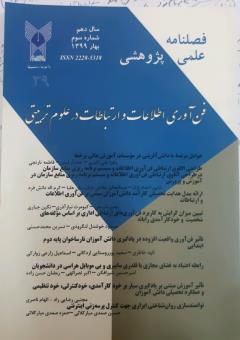طراحی الگوی دانشگاه هوشمند مبتنی بر اینترنت اشیاء و هوش مصنوعی
محورهای موضوعی : فن‎آوری اطلاعاتزهرا حیدری 1 , زهرا طالب 2 , زینب گلزاری 3
1 - علوم تربیتی، دانشگاه آزاد، تهران جنوب، تهران
2 - استادیار، گروه علوم تربیتی، واحد تهران جنوب، دانشگاه آزاد اسلامی ، تهران
3 - استادیار دانشکده روانشناسی و علوم تربیتی دانشگاه آزاد اسلامی / واحد تهران جنوب
کلید واژه: دانشگاه هوشمند, اینترنت اشیاء, هوش مصنوعی, تحلیل مضمون, دلفی,
چکیده مقاله :
روی کار آمدن فناوریهای نوین به خصوص هوش مصنوعی و اینترنت اشیاء، تعریف دانشگاه در قرن بیست و یکم را به سمت دانشگاه هوشمند تغییر داد. در دانشگاه هوشمند فضاها با استفاده از اینترنت اشیاء و هوش مصنوعی به محیطی امن و تحت کنترل و هوشمندانه برای فراگیران تبدیل میشود. با توجه به اهمیت هوشمندسازی دانشگاه همگام با سایر کشورها، پژوهش حاضر به دنبال ارائه الگوی دانشگاه هوشمند مبتنی بر اینترنت اشیاء و هوش مصنوعی میباشد. روش پژوهش از نوع کیفی بود و با استفاده از مصاحبههای نیمهساختاریافته با خبرگان اطلاعات لازم جمعآوری و با هدف استخراج عناصر و اجزای مدل، این اطلاعات براساس روش تحلیل مضمون کدگذاری شد. جامعه آماری پژوهش شامل خبرگان دانشگاهی از رشتههای تکنولوژی آموزشی، مدیریت آموزش عالی، فناوری اطلاعات و ارتباطات و هوش مصنوعی به تعداد 23 نفر بود. نمونهگیری به صورت هدفمند و گلوله برفی انجام شد. برای اعتباریابی شبکه مضامین از تکنیک دلفی استفاده شد. یافتههای پژوهش نشان داد که الگوی دانشگاه هوشمند مبتنی بر اینترنت اشیاء و هوش مصنوعی دارای 15 مولفه و 70 زیرمولفه است.
The use of new technologies, especially artificial intelligence and the Internet of Things, changed the definition of a university in the 21st century towards a smart university. In the smart university, spaces are transformed into a safe, controlled and intelligent environment for learners using the Internet of Things and artificial intelligence. Considering the importance of making the university smart in line with other countries, the current research seeks to provide a model of a smart university based on the Internet of Things and artificial intelligence. The research method was qualitative and by using semi-structured interviews with experts, necessary information was collected and with the aim of extracting the elements and components of the model, this information was coded based on thematic analysis method. The statistical population of the research included 23 academic experts from the fields of educational technology, higher education management, information and communication technology, and artificial intelligence. Sampling was done in a targeted and snowball way. Delphi technique was used to validate the theme network. The research findings showed that the smart university model based on Internet of Things and artificial intelligence has 15 components and 70 sub-components.


